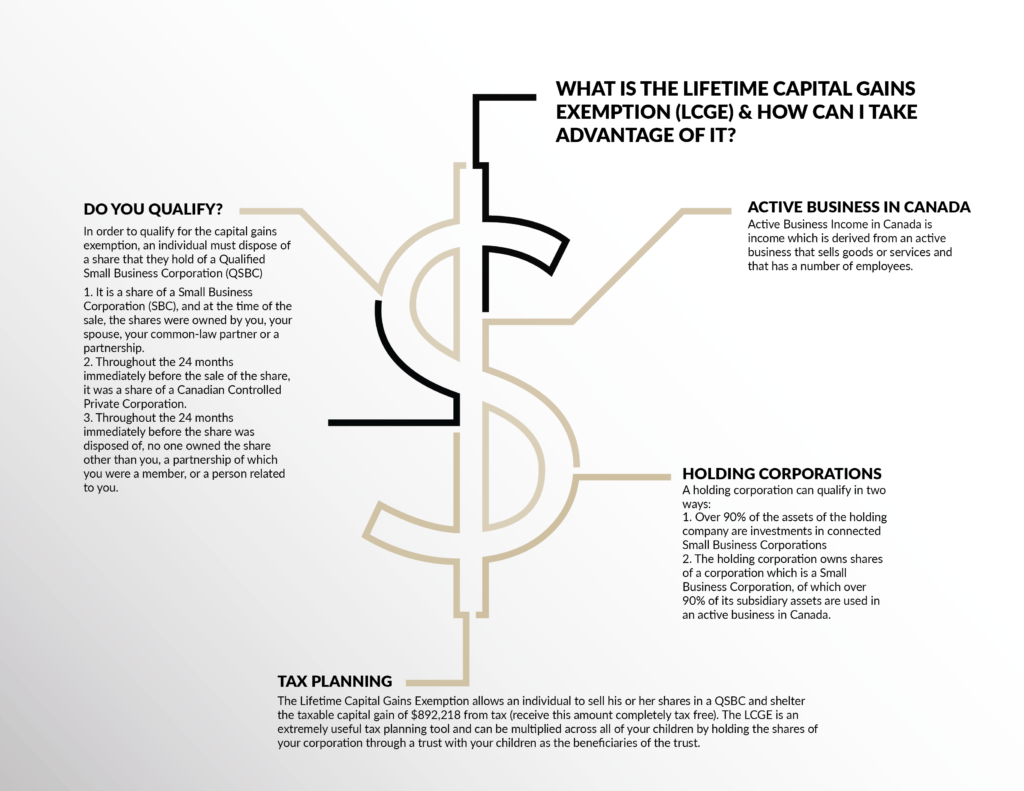Lifetime Capital Gains Exemption Canada: What Is It & How Can I Take Advantage of it?
What is the Lifetime Capital Gains Exemption?
The Lifetime Capital Gains Exemption (LCGE) is an exemption of capital gains tax that arises when small business corporation (SBC) shares are sold in Canada. The impetus for the LGCE was to bolster investment in small businesses in Canada. That is, the government sought to incentivise individuals to invest in small businesses in Canada by providing them with a tax exemption on the taxable capital gain that arises on the eventual disposition of the shares issued in exchange for the investment.

For this reason, not all corporations qualify for the Lifetime Capital Gains Exemption. Only corporations that produce Active Business Income (ABI) will qualify. The reason for this hearkens back to the purpose of this type of tax exemption. The LCGE is only available for businesses that create jobs, wealth and grow our economy; but is not available for holding corporations that hold assets and merely accrue passive income such as rental income or intercorporate dividends (where no employment is needed in order to produce the income).
Presently, the LCGE is $892,218 in 2021. This means that an individual can sell his or her shares in a QSBC and shelter the taxable capital gain up to $892,218 from tax (meaning receive this amount completely tax free).
Does Your Corporation Qualify for the Lifetime Capital Gains Exemption?
In order to qualify for the capital gains exemption in Canada, an individual must dispose of a share that they hold of a Qualified Small Business Corporation (QSBC).
A QSBC is a share of a corporation that meets the following criteria:
1. It is a share of a Small Business Corporation (SBC), and at the time of the sale, the shares were owned by you, your spouse, your common-law partner or a partnership.
A Small Business Corporation is a corporation that: a. Is Canadian-controlled (controlled by residents of Canada), and private (its shares are not listed on any exchange), and b. in which all or most (90% or more) of the fair market value of its assets:
-
- are used mainly in an active business carried on primarily in Canada by the corporation or by a related corporation;
- are shares or debts of connected corporations that were small business corporations; or
- are a combination of these two types of assets.
2. Throughout the 24 months immediately before the sale of the share, it was a share of a Canadian Controlled Private Corporation (CCPC, see definition above) and more than 50% of the fair market value of the assets of the corporation were:
-
- used mainly in an active business carried on primarily in Canada by the Canadian-controlled private corporation, or by a related corporation;
- certain shares or debts of connected corporations; or
- a combination of these two types of assets; and
3. Throughout the 24 months immediately before the share was disposed of, no one owned the share other than you, a partnership of which you were a member, or a person related to you.

How Can I Make Sense of This Convoluted Test?
First, it is important to understand the difference between the test outlined in number 1 and number 2 above. The first test is to determine whether the corporation qualifies and is not concerned with the shareholder. As well, the first test is measured at the time of the sale. The second test is a holding period of ownership test which looks to the shareholder not at the time of the sale but his/her status during the 24-month period prior to the sale.
The first test is satisfied if, at the time of the sale, over 90% of the assets of the corporation or its holding corporation were used in an active business in Canada. The second test is satisfied if the shares were held consistently by you or a relative for the preceding 24-month period and, during that 24-month period, over 50% of the assets of the corporation were used in an active business in Canada.
The third aspect of the test seeks to ensure that you held the shares consistently over the preceding 24-month period. This prevents someone from investing in a corporation, acquiring the shares and immediately disposing of them to take advantage of the tax-free exemption.
So, what is an active business in Canada? Income from most businesses qualify as Active Business Income (ABI). However, active business income does not include investment income, income from a specified investment business (SIB) or income from a personal services business (PSB). ABI also does not include passive income which is income derived from rent, interest, royalties or dividends. In plain language, Active Business Income in Canada is income which is derived from an active business that sells goods or services and that has a number of employees.
Does a Holding Corporation Qualify for the Lifetime Capital Gains Exemption?
In short, yes, it can. A holding corporation fits within the definition of Small Business Corporation in test number 1 above. A holding corporation can qualify in two ways:
i. Over 90% of the assets of the holding company are investments in connected Small Business Corporations (Most if not all of the assets of the holding corporation are shares of an active operating corporation); or
ii. The holding corporation owns shares of a corporation which is a Small Business Corporation, of which over 90% of its subsidiary assets are used in an active business in Canada. In this circumstance, over 50% of the assets of the holding corporation during the preceding 24 months must have been used mainly in an active business carried on primarily in Canada or more than 50% of the assets of the holding corporation during the preceding 24 months must have been certain shares or debts of connected corporations.

Tax Planning – Purify the Corporation
If you plan to sell or transfer shares of a QSBC, a common strategy is to “purify” the corporation prior to the sale. Purification includes taking action to dispose of or change the structure of the corporation to meet the definitions above. Typically, this involves stripping the corporation of certain holding assets that dilute its value such that it can meet the 90% or 50% threshold tests.
A common tax planning tool is combining the Lifetime Capital Gains Exemption with the s.85 rollover. If you own a business as a sole proprietor and you are one day hoping to sell your business, we strongly advise that you transfer your assets to a newly formed corporation under s.85 of the Income Tax Act which rolls over the assets on a tax neutral basis (no tax is paid on the transfer). Then, the corporation must wait throughout the 24-month holding period to qualify as a QSBC. Once 24 months have elapsed, and the corporation meets the test outlined above, the corporation can sell its shares to a prospective buyer, and the seller or owner of the business is afforded a tax-free gain of up to $892,218 (in 2021) on the sale of its business.
Lifetime Capital Gains Exemption – Indexed to Inflation
Presently, the LCGE is $$892,218 in 2021. The threshold cap is indexed to inflation, increasing incrementally each year pegged to the Consumer Price Index. For the list of pegged personal income tax and benefit amounts for 2018 set out by Canada Revenue, Click Here.
As such, the Lifetime Capital Gains Exemption allows an individual to sell his or her shares in a QSBC and shelter the taxable capital gain of $892,218 from tax (receive this amount completely tax free). The LCGE is an extremely useful tax planning tool and can be multiplied across all of your children by holding the shares of your corporation through a trust with your children as the beneficiaries of the trust.
For more information on the LCGE and whether your corporation may qualify, Contact Us.
-Shira Kalfa, BA, JD, Partner and Founder
Shira Kalfa is the founding partner of Kalfa Law Firm. Shira’s practice is focused in corporate-commercial and tax law including corporate reorganizations, corporate restructuring, mergers and acquisitions, commercial financing, secured lending and transactional law. Shira graduated from York University achieving the highest academic accolade of Summa Cum Laude in 2012. She graduated from Western Law in 2015, with a specialization in business law. Shira is licensed to practice by the Law Society of Ontario. She is also a member of the Ontario Bar Association, the Canadian Tax Foundation, Women’s Law Association of Ontario, and the Toronto Jewish Law Society.
© Kalfa Law 2021
The above provides information of a general nature only. This does not constitute legal advice. All transactions or circumstances vary, and specified legal advice is required to meet your particular needs. If you have a legal question you should consult with a lawyer.















